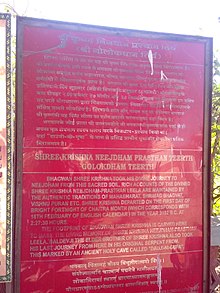Kali Yuga, in Hinduism, is the fourth and worst of the four yugas (world ages) in a Yuga Cycle, preceded by Dvapara Yuga and followed by the next cycle’s Krita (Satya) Yuga. It is believed to be the present age, which is full of conflict and sin.
According to Puranic sources, Krishna’s death marked the end of Dvapara Yuga and the start of Kali Yuga, which is dated to 17/18 February 3102 BCE. Lasting for 432,000 years (1,200 divine years), Kali Yuga began 5,125 years ago and has 426,875 years left as of 2024 CE. Kali Yuga will end in the year 428,899 CE.
Near the end of Kali Yuga, when virtues are at their worst, a cataclysm and a re-establishment of dharma occur to usher in the next cycle’s Krita (Satya) Yuga, prophesied to occur by Kalki.
Etymology
Yuga (Sanskrit: युग), in this context, means “an age of the world”, where its archaic spelling is yug, with other forms of yugam, yugānāṃ, and yuge, derived from yuj (Sanskrit: युज्, lit. ‘to join or yoke’), believed derived from *yeug- (Proto-Indo-European: lit. ‘to join or unite’).
Kali Yuga (Sanskrit: कलियुग, romanized: kaliyuga or kali-yuga) means “the age of Kali (demon)”, “the age of darkness”, “the age of vice and misery”, or “the age of quarrel and hypocrisy”.
A complete description of Kali Yuga is found in the Mahabharata, Manusmriti, Vishnu Smriti, and various Puranas. It is used mathematically in the astronomical texts Aryabhatiya and Surya Siddhanta.
Epigraphy
According to P. V. Kane, one of the earliest inscriptions with one of the four yugas named is the Pikira grant of Pallava Simhavarman (mid-5th century CE):
Who was ever ready to extricate dharma that had become sunk owing to the evil effects of Kaliyuga.
— Pikira grant of Pallava Simhavarman, line 10 (3rd plate, front)
Other epigraphs exist with named yugas in the Old Mysore region of India, published in Epigraphia Carnatica.
Start date

According to the Surya Siddhanta, Kali Yuga began at midnight (00:00) on 18 February 3102 BCE. This is also considered the date on which Krishna left the earth to return to Vaikuntha. This information is placed at the temple of Bhalka, the place of this incident (see photo).
According to the astronomer and mathematician Aryabhata, Kali Yuga started in 3102 BCE. He finished his book Aryabhattiyam in 499 CE, in which he gave the exact year of the beginning of Kali Yuga. He writes that he wrote the book in the “year 3600 of the Kali Age” at the age of 23. As it was the 3600th year of the Kali Age when he was 23 years old, and given that Aryabhata was born in 476 CE, the beginning of the Kali Yuga will come to (3600 – (476 + 23) + 1 (One year from 1 BCE to 1 CE)) = 3102 BCE.
According to K. D. Abhyankar, the starting point of Kali Yuga is an extremely rare planetary alignment, which is depicted in the Mohenjo-daro seals. Going by this alignment, the year 3102 BCE is slightly off. The actual date for this alignment is 7 February 3104 BCE. There is also sufficient proof to believe that Vrddha Garga knew of precessions at least by 500 BCE. Garga had calculated the rate of precession to within 30% of what the modern scholars estimate.
Duration and structure
Hindu texts describe four yugas (world ages) in a Yuga Cycle, where, starting in order from the first age of Krita (Satya) Yuga, each yuga’s length decreases by one-fourth (25%), giving proportions of 4:3:2:1. Each yuga is described as having a main period (a.k.a. yuga proper) preceded by its yuga-sandhyā (dawn) and followed by its yuga-sandhyāṃśa (dusk), where each twilight (dawn/dusk) lasts for one-tenth (10%) of its main period. Lengths are given in divine years (years of the gods), each lasting for 360 solar (human) years.
Kali Yuga, the fourth age in a cycle, lasts for 432,000 years (1,200 divine years), where its main period lasts for 360,000 years (1,000 divine years) and its two twilights each lasts for 36,000 years (100 divine years). The current cycle’s Kali Yuga, the present age, has the following dates based on it starting in 3102 BCE:
| Part | Start (– End) | Length |
|---|
